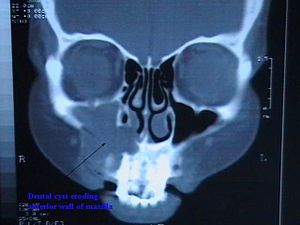Periapical cyst
| Periapical cyst | |
|---|---|
 |
|
| CT scan through head showing a right periapical cyst | |
| Classification and external resources | |
| Specialty | endodontics |
| ICD-10 | K04.8 |
| DiseasesDB | 31994 |
| eMedicine | ent/681 |
The periapical cyst (also termed radicular cyst, and to a lesser extent dental cyst) is the most common cyst of the jaw. It is caused by pulpal necrosis secondary to dental caries or trauma. The cyst lining is derived from the cell rests of Malassez. Usually, the periapical cyst is asymptomatic, but a secondary infection can cause pain. On radiographs, it appears a radiolucency (dark area) around the apex of a tooth's root.
Radicular cyst is the most common odontogenic cystic lesion of inflammatory origin. It is also known as periapical cyst, apical periodontal cyst, root end cyst or dental cyst. It arises from epithelial residues in periodontal ligament as a result of inflammation. The inflammation usually follows death of dental pulp. Radicular cysts are found at root apices of involved teeth. These cysts may persists even after extraction of offending tooth; such cysts are called residual cysts.
It is defined as an odontogenic cyst of Inflammatory origin that is preceded by a chronic periapical granuloma and stimulation of cell rests of malassez present in the periodontal membrane.
It is classified as follows:
1) Periapical Cyst: These are the radicular cysts which are present at root apex.
2) Lateral Radicular Cyst:- These are the radicular cysts which are present at the opening of lateral accessory root canals of offending tooth.
3) Residual Cyst:- These are the radicular cysts which remains even after extraction of offending tooth.
Dental cysts are usually caused due to root infection involving the tooth affected greatly by carious decay . The resulting pulpal necrosis causes release of toxins at the apex of the tooth leading to periapical inflammation. This inflammation leads to the formation of reactive inflammatory (scar) tissue called periapical granuloma further necrosis and damage stimulates the Malassez epithelial rests, which are found in the periodontal ligament, resulting in the formation of a cyst that may be infected or sterile (The epithelium undergoes necrosis and the granuloma becomes a cyst). These lesions can grow into large lesions because they apply pressure over the bone causing resorption. The toxins released by the breakdown of granulation tissue is one of the common causes of bone resorption.
...
Wikipedia
